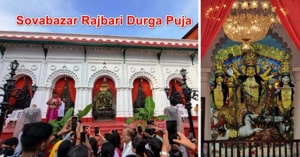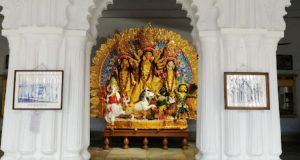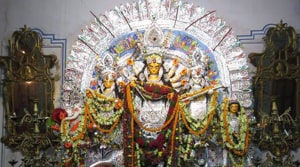The Royal Dawn of Durga Puja: Shobhabazar Rajbari’s Unmatched Legacy
In the heart of North Kolkata’s old world charm, the Shobhabazar Rajbari Durga Puja emerges as one of the  most iconic and historically rich celebrations in Bengal. This grand family puja, launched in 1757 by the visionary Raja Nabakrishna Deb, remains a beacon of Bengali tradition, aristocratic grandeur, and cultural pride—carrying forward a legacy that intertwines colonial history with the resurgence of Bengal’s spiritual and cultural identity.
most iconic and historically rich celebrations in Bengal. This grand family puja, launched in 1757 by the visionary Raja Nabakrishna Deb, remains a beacon of Bengali tradition, aristocratic grandeur, and cultural pride—carrying forward a legacy that intertwines colonial history with the resurgence of Bengal’s spiritual and cultural identity.
During Durga Puja 2025, the sprawling rajbari transforms into a majestic spectacle where heritage meets devotion, offering visitors an immersive experience of rituals that have been passed down for over two and a half centuries. For detailed directions, entry protocols, and cultural notes, seekers of tradition can find rich curated guides at https://www.pujo2pujo.com/.
Historical Foundations: A Puja That Shaped Bengal’s Cultural Renaissance
The origins of the Shobhabazar Rajbari Durga Puja are deeply entwined with the monumental events of 1757, the year the British East India Company consolidated power in Bengal after the Battle of Plassey. Raja Nabakrishna Deb, a man of political acumen and cultural foresight, started this puja at his family palace on Raja Nabakrishna  Street as a celebration not just of devotion, but also of Bengali identity amidst colonial influences.
Street as a celebration not just of devotion, but also of Bengali identity amidst colonial influences.
The Rajbari’s puja gained fame early on as it attracted prominent guests such as Lord Clive and Warren Hastings, blending political prominence with cultural spectacle. It soon set the tone for Bengal’s emerging Durga Puja culture, inspiring noble families and merchant communities alike to host their own grand celebrations, making Durga Puja a centerpiece of Bengal’s social and cultural renaissance.
2025 Family Rituals: Deep Tradition & Spiritual Grandeur
Each year, the Shobhabazar Rajbari family follows age-old rituals meticulously preserved:
-
Bodhon Ceremony: The formal awakening of Maa Durga under the sprawling courtyard’s canopy, performed by the eldest family member alongside priests versed in Vedic chants.
-
Anjali and Bhog: Family and invited devotees gather for heartfelt anjali prayers. The bhog menu features traditional fare—shada bhat, labra, khichuri, and payesh—prepared in ancestral kitchens using recipes handed down over generations.
-
Sandhi Puja: As the transition from Ashtami to Nabami arrives, the courtyard resonates with a spectacular lighting of 108 lamps, symbolic chants, and emotional hymns, regarded as the spiritual zenith of the puja.
-
Sindoor Khela & Visarjan: On Dashami, married women joyously smear sindoor, marking both celebration and solemn farewell as the idol is carried through ceremonial processions for immersion.
Each ritual is a celebration of family, faith, and cultural continuity—uncut by time or modernity.
Architectural Majesty and Decor: The Rajbari’s Eloquent Grandeur
The Shobhabazar Rajbari’s architectural design is a living museum—its Doric columns, lofty verandahs,  wooden sculptures, and ancestral paintings vividly narrate tales of Kolkata’s bygone eras. The thakurdalan, central to the celebrations, is draped with marigold garlands, fresh banana leaves, and traditional alpana art created by family members and artisans.
wooden sculptures, and ancestral paintings vividly narrate tales of Kolkata’s bygone eras. The thakurdalan, central to the celebrations, is draped with marigold garlands, fresh banana leaves, and traditional alpana art created by family members and artisans.
The idol, magnificently crafted in the Daaker Saaj (traditional Bengali style), stands on a wooden palette framed by antique brass lamps and colorful marigold arrays, creating an aura of both historic reverence and vibrant festivity.
Cultural Celebrations: Music, Literature & Intellectual Heritage
Shobhabazar Rajbari’s Durga Puja is as much an intellectual and artistic meet as a religious festival. The evenings echo with Rabindra Sangeet, classical recitals, and baul folk songs performed by local and invited artists. The Rajbari remains an important cultural hub, historically linked to legends such as Rabindranath Tagore, Raja Ram Mohan Roy, and Swami Vivekananda, who frequented the mansion.
Visitors can witness storytelling sessions, poetry recitations, and art exhibitions that underscore Bengal’s literary and cultural greatness.
How to Reach Shobhabazar Rajbari: Route Map and Tips
Starting Points:
-
Girish Park Metro Station: Approximately 1 km walking distance
-
Shyambazar Metro Station: Approximately 1.5 km walking distance
Directions:
-
From Girish Park, head north on Maharaja Manindra Road.
-
Turn left onto Raja Nabakrishna Street.
-
Look for the grand colonial mansion adorned with colorful festive decorations and throngs of devotees.
Nearby Landmarks:
-
Jorasanko Thakurbari (Rabindranath Tagore’s ancestral home)
-
Sovabazar Rajbari (nearby aristocratic puja house)
-
Rabindra Bharati University
Festival Travel Tips:
-
Start your visit early morning to avoid crowd rush.
-
Local guides and volunteers are available to assist through the puja complex.
-
Photography is usually permitted in outdoor areas; seek permissions around restricted zones.
Comprehensive route maps and festival updates can be found embedded in the https://www.pujo2pujo.com/ heritage guides, offering valuable assistance for puja procession planning and parikrama.
Why Shobhabazar Rajbari Durga Puja 2025 is A Must-Experience
Attending the Shobhabazar Rajbari Durga Puja is like stepping through a portal of Bengal’s rich heritage and spiritual core. Its timeless rituals, respectable lineage, and cultural vibrancy capture the essence of a tradition that has shaped Kolkata for generations. The 2025 celebration promises to uphold this magnificent heritage with all the fervor and elegance expected of Raja Nabakrishna Deb’s legacy.
Whether a cultural enthusiast, devotee, or history seeker, this puja is an unparalleled gateway to understanding Kolkata’s soul.
Delve deep into the heart of North Kolkata’s aristocratic grandeur—walk the grand halls, partake in ancient rituals, and witness heritage Durga Puja at the iconic Shobhabazar Rajbari, where history and divinity meet every autumn.
For detailed schedules, visitor information, and VIP access tips, explore the rich resources tucked within https://www.pujo2pujo.com/.




